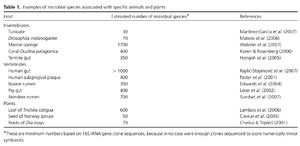The Hologenome Theory of Evolution
Introduction
The hologenome theory is a postulate put forth in 2007 by Eugene Rosenberg and Ilana Zilber-Rosenburg stating that the object of genomic natural selection is not a single organism, but the organism and its microbial communities (Rosenburg et al., 2007). This theory was originally based on the pair’s observations of Vibrio shiloi-mediated bleaching of the coral Oculina patagonica (Rosenburg & Zilber-Rosenburg, 2008); since its first introduction, the theory has been promoted as a fusion of Lamarckism and Darwinism (Rosenburg, Sharon, and Zilber-Rosenburg, 2009) and expanded to all of evolution, not just that of corals (Rosenburg & Zilber-Rosenburg, 2011). Recent research by the Rosenburg lab suggests that commensal bacteria play a role in mate choice by the fruit fly, Drosophila melanogaster, further supporting the hypothesis that greater genetic trends are determined by symbiotic microbiota (Sharon et al., 2010).
Double brackets: [[
Filename: PHIL_1181_lores.jpg
Thumbnail status: |thumb|
Pixel size: |300px|
Placement on page: |right|
Legend/credit: Electron micrograph of the Ebola Zaire virus. This was the first photo ever taken of the virus, on 10/13/1976. By Dr. F.A. Murphy, now at U.C. Davis, then at the CDC.
Closed double brackets: ]]
Other examples:
Bold
Italic
Subscript: H2O
Superscript: Fe3+
The Hologenome
The Coral Probiotic Hypothesis
Corals are a symbiotic partnership of many different marine bacteria, archaea, and eukaryotes with the invertebrate coral structure (Kushmaro & Rosenburg, 1997). Bleaching, or the loss of photosynthetic zooxanthellae from corals, is detrimental to the reef environment, as it inhibits shoal development and decreases biological production in the shallow ocean (Slonczewski & Foster, 2011). The 1980s and 1990s saw multiple large-scale bleachings of coral across the world’s oceans, largely the result of increases in ocean temperature (Goreau et al., 2000). Research of the Mediterranean coral bleaching in the mid-1990s used Koch’s postulates to show that growth of Vibrio shiloi, a gamma-proteobacterium, on the coral was responsible for the death of the required zooxanthellae (Fine & Loya, 1995; Kushmaro & Rosenburg, 1997).
In 2006, the Rosenburg lab published a paper titled “The Coral Probiotic Hypothesis” in the Journal of Environmental Microbiology (Reshef et al., 2006). Drawing from Fine & Loya’s (1995) findings along the knowledge that changes in populations of microbes can allow the entry and growth of pathogenic species (Bignardi, 1998), Following the lab’s past conclusions, Reshef et al. asserted that temperature-mediated changes in symbiote species makeup allowed the colonization of the coral by Vibrio shiloi, and thus permitted the bleaching (Kushmaro & Rosenburg, 1997). Taking into consideration their more recent research that showed the development of resistance within coral populations shortly after the worst bleaching event in 1998 (Goreau et al., 2000), Reshef et al. argued that the a change of microbial communities within the coral—due to natural selection pressures exerted by the change in temperature—was responsible for macroscale adaptation on the part of the whole coral (2006).
The Holobiont
The idea of holobiont is certainly not new: this term was coined originally by Margulis and Foster in 1991, and was then appropriated for use in reference to the large symbiotic communities residing in coral reefs (Rowan, 1998). In general, a holobiont is any organism and all of its associated symbionts, including parasites, mutualists, synergists, and amensalists (Rosenburg & Zilber-Rosenburg, 2011). This is the unit of selection in the hologenome theory.
The Hologenome
In the hologenome theory, natural selection works on the level of simple Mendelian genetics, but also on a bigger scale. Because the microbes associated with the larger host are so intimately tied to the organism, changes in either host environment or microenvironments within the host can cause changes in microbial genomes (Erlich, Hiller, & Hu, 2008; Gilbert et al., 2010). Thus, the genome being selected is not simply the host’s, but the hologenome—the genes of all of the microbiota as well as those of the larger organism (Rosenburg, Sharon, & Zilber-Rosenburg, 2009).
Larmarckism vs. Darwinism
Include some current research in each topic, with at least one figure showing data.
Microbes' Influence on Mate Selection
Include some current research in each topic, with at least one figure showing data.
Conclusion
Overall paper length should be 3,000 words, with at least 3 figures.
References
Edited by Rachel Martin, student of Joan Slonczewski for BIOL 238 Microbiology, 2009, Kenyon College.

